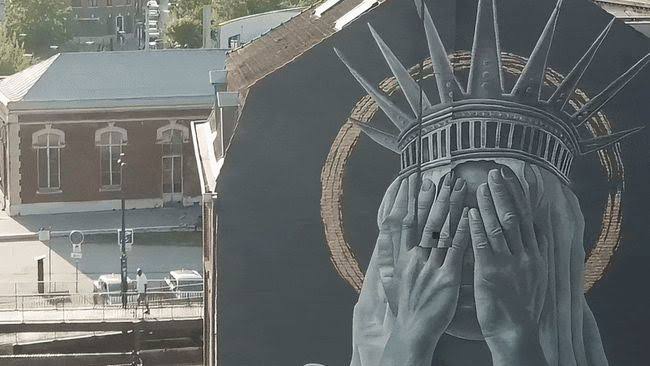Just days before American Independence Day, residents of Roubaix, a small industrial city in northern France, gathered around a newly unveiled mural that few could have expected. Painted across a crumbling brick wall on Rue de l’Espérance, the work shows the familiar figure of the Statue of Liberty—but with her face buried in her hands. The torch she usually holds high hangs limp at her side. Instead of triumph, there is only quiet despair.
The artist, who signs simply as “Éloi,” didn’t choose the date by accident. Speaking to onlookers after the cloth was pulled away, Éloi explained why Lady Liberty no longer stands proud: “She was meant to welcome the stranger, the refugee, the outcast. Today, she can only watch what’s happening—and turn away in shame.”
Painted in muted greys and rust, the mural stretches nearly five metres wide. Éloi avoided dramatic slogans or hashtags. Instead, the artist relied on the power of the image itself—a national symbol built on hope, now bowed under the weight of real policies.
Locals passing by stopped to stare, some nodding in quiet agreement, others taking photos to share online. A few visitors admitted they didn’t fully grasp the context until they heard Éloi speak. “It’s not just about what America says,” the artist explained. “It’s what America does: children separated from their parents, families detained behind fences, and people left waiting in dangerous camps because someone decided they were ‘less deserving.’”
The timing made the statement sharper. As Americans prepared for fireworks and speeches celebrating freedom, the mural asks what that freedom means when migrants and asylum seekers remain trapped in bureaucratic limbo, or worse, forcibly sent back to the places they fled.
In Roubaix, a city shaped by generations of immigration—first from Belgium, later from North Africa, and more recently from the Middle East—the question isn’t abstract. Many residents know the fear of family members being denied visas, or the uncertainty of temporary permits. One woman at the unveiling, whose grandparents came from Algeria, said softly, “We still call her the Statue of Liberty, but it hurts to see what’s become of her promise.”
Éloi chose Roubaix, not Paris or Marseille, because, as they put it, “This is a city built by those who arrived with nothing, looking for a place to belong.” The location itself—a half-abandoned warehouse slated for demolition in the coming years—adds an extra layer. “Nothing lasts forever,” Éloi said. “Not even the image of Liberty, if we don’t protect what she stands for.”
“If the image makes people angry,” they said, “maybe they should ask why.”






2 thoughts on “A Mural in France Confronts America’s Immigration Shame”
As an American, I express my profound gratitude to artist Éloi for capturing this moment.
I always knew America had a problem with its citizens being willfully ignorant. What I didn’t know until the short-fingered vulgarian managed to seize power 9 years ago was how many Americans would eagerly embrace fascism, how cruel and craven the TrumpliQan Party is, how feckless the Democratic Party is, and how inept and captured our ‘free’ press is.
Many of us are horrified at what has happened… just not enough
Thank you Eloi for doing such a great image of the LIBERTY.